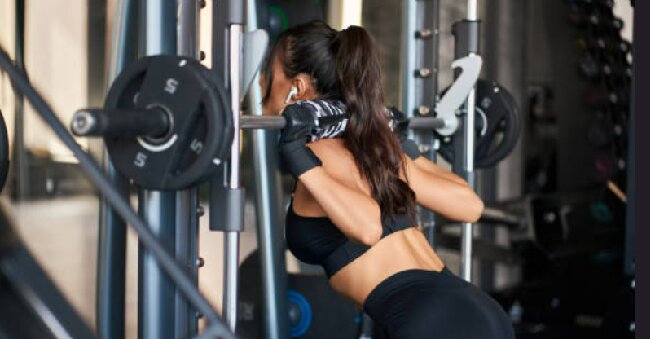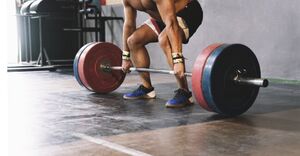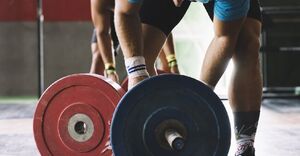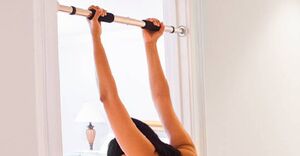
7 Powerful Benefits of Deep Squats on a Smith Machine: Transform Your Leg Workout
Have you ever wondered about the benefits of deep squats on the Smith machine?
We will explore how deep squats differ from regular squats, which muscles they target, and why they are beneficial.
We will also discuss the proper technique for performing deep squats on the Smith machine, common mistakes to avoid, and tips for mastering this challenging exercise.
Enhance your muscle isolation and strength by learning more about deep squats on the Smith machine!
What Is the Smith Machine?
The Smith Machine is a versatile piece of equipment commonly found in gyms, offering a guided barbell system for weightlifting exercises.
It typically consists of a vertical steel frame with a barbell attached to a sliding track, allowing for controlled and stable movements during exercises. The adjustable safety catches provide added security for solo workouts, making it a popular choice for fitness enthusiasts looking to safely perform heavy lifts. Many people appreciate the Smith Machine for its versatility in targeting different muscle groups and the added stability it offers compared to traditional free weights. It has become a staple in strength training routines, helping individuals achieve their fitness goals efficiently.
What Are Deep Squats on the Smith Machine?
Deep squats on the Smith Machine refer to performing squats with a full range of motion using the guided barbell system for enhanced muscle activation and isolation.
Engaging in deep squats on the Smith Machine ensures that your form remains consistent throughout the movement, minimizing the risk of injury. By stabilizing the barbell on the machine’s guided track, you can focus solely on your squat technique and muscle engagement without worrying about balancing the weight. This setup allows for targeted activation of the quadriceps, hamstrings, glutes, and core muscles, leading to a more comprehensive lower body workout. The controlled movement provided by the Smith Machine also helps in building strength and muscle endurance, making it a valuable tool for squat variations and progression.
How Are Deep Squats Different from Regular Squats?
Deep squats differ from regular squats by requiring a deeper range of motion that activates more muscle groups, particularly targeting the quadriceps, glutes, and hamstrings.
Incorporating deep squats into your workout routine can help in engaging the muscles more intensively as the increased range of motion activates the muscles to a greater extent. This added depth challenges the lower body muscles, such as the quadriceps and glutes, by placing a greater demand on them. This, in turn, can lead to enhanced muscle growth and overall strength development.
By delving deeper into the squat position, you are tapping into a wider network of muscles, optimizing muscle activation and targeting different areas of the lower body with more emphasis and precision.
What Muscles Does Deep Squats on the Smith Machine Target?
Deep squats on the Smith Machine effectively target major muscle groups such as the quadriceps, glutes, and hamstrings due to the enhanced muscle activation provided by the guided barbell system.
When performing deep squats on the Smith Machine, the quadriceps play a crucial role in extending the knee joint, particularly during the upward phase. This movement heavily recruits the vastus medialis, vastus lateralis, and rectus femoris, leading to significant strength gains in the front of the thigh. Simultaneously, the glutes are heavily engaged to provide hip extension, helping to stabilize the pelvis and maintain proper form. The hamstrings act dynamically as well, aiding in the hip joint movement and assisting in the knee flexion phase of the squat.
Why Are Deep Squats on the Smith Machine Beneficial?
Deep squats on the Smith Machine offer significant benefits, including enhanced muscle isolation, reduced risk of injury, and increased range of motion for optimal lower body development.
Engaging in deep squats on the Smith Machine allows you to target specific muscle groups with precision, leading to more effective results in strengthening and sculpting your lower body. By isolating muscles such as the quadriceps, hamstrings, and glutes, you can experience greater muscle activation and growth compared to traditional squat variations.
The guided movement pattern on the Smith Machine helps stabilize your form, reducing the likelihood of straining or injuring yourself during the exercise. This controlled environment promotes proper technique, ensuring that you maximize the benefits of each repetition for long-term progress in your fitness journey.
Enhanced Muscle Isolation
Enhanced muscle isolation during deep squats on the Smith Machine leads to more targeted muscle activation, promoting greater strength gains and muscle growth over time.
By focusing on proper form and depth in your squatting movements, you can engage specific muscle groups more effectively, stimulating them to adapt and grow stronger. This enhanced muscle isolation not only boosts strength gains but also helps in preventing the dominance of larger muscle groups, resulting in a more balanced physique.
When you prioritize muscle activation through deep squats, you create a solid foundation for overall strength training, allowing you to push through plateaus and achieve continuous progress in your fitness journey.
Reduced Risk of Injury
Performing deep squats on the Smith Machine with proper form and technique reduces the risk of injury by ensuring optimal body mechanics, stability, and muscle engagement.
When executing deep squats on the Smith Machine, it is crucial to maintain a neutral spine, engage the core muscles, and keep the knees aligned with the toes. These key elements not only enhance the effectiveness of the exercise but also play a significant role in preventing strain on the lower back and knees. By focusing on safety and proper technique, individuals can cultivate a strong foundation for their squatting movements, leading to improved strength, endurance, and overall fitness levels.
Increased Range of Motion
Deep squats on the Smith Machine facilitate an increased range of motion, promoting better flexibility in the lower body while effectively engaging the quadriceps and glutes.
By allowing a deeper squat position, the Smith Machine helps to stretch and strengthen muscles throughout the lower body, enhancing mobility and reducing the risk of injuries. This extended range of motion also targets the glutes more intensely, aiding in their development and toning. Improved flexibility from deep squats can contribute to better overall functional movement patterns and athletic performance. Consistent practice of deep squats on the Smith Machine can lead to significant improvements in lower body strength, stability, and muscle coordination.
How to Perform Deep Squats on the Smith Machine?
Mastering deep squats on the Smith Machine requires a combination of proper techniques, core stability, and precise body mechanics to maximize muscle activation and strength gains.
- Begin by setting the bar on the Smith Machine at an appropriate height, typically around shoulder level.
- Stand underneath the bar with your feet shoulder-width apart and your chest up. Lower yourself down slowly by bending your knees, ensuring they track over your toes. Engage your core muscles throughout the movement to maintain stability.
- Aim to lower until your thighs are parallel to the ground or below for a deep squat. Push through your heels as you return to the starting position, exhaling as you stand back up. Repeat the movement while focusing on maintaining proper form and core stability.
Adjust the Height of the Bar
Before starting deep squats on the Smith Machine, ensure to adjust the height of the barbell to align with your stance and comfort level for a safe and effective workout.
This initial step is crucial as improper barbell height may lead to discomfort, compromised form, or even injury during the squat. By setting the barbell at a level that allows you to unrack and rack it easily without straining, you can focus on maintaining proper alignment throughout the exercise.
Your stance plays a significant role in ensuring that the barbell rests securely on your upper back while providing a stable base for the movement. It’s essential to find a height that promotes a natural range of motion for your body, helping you achieve deep squats without unnecessary strain.
Position Yourself Under the Bar
Properly position yourself under the bar of the Smith Machine with correct foot placement to establish a stable base and ensure balanced weight distribution during deep squats.
- For optimal performance during deep squats, your foot placement is crucial. Ensure that your feet are shoulder-width apart or slightly wider to provide a solid foundation.
- As you descend into the squat, focus on keeping your weight evenly distributed across both feet. This will help maintain balance and prevent any unnecessary strain on your joints.
- Make sure your knees track in line with your toes to avoid any potential discomfort or injury.
By maintaining proper foot placement and weight distribution, you can enhance your squatting technique and see improved results in your lower body strength training.
Grip the Bar and Unrack It
Maintain a firm grip on the barbell and unrack it smoothly to initiate the deep squat movement with control and focus on muscle activation and proper form.
The secure grip on the barbell not only ensures safety but also plays a crucial role in activating the muscles effectively during squats. By maintaining control during unracking, you set the foundation for a stable squatting position, allowing for optimal muscle engagement and improved form.
When the barbell is securely held, it enables a strong connection between the upper body and lower body, promoting better overall coordination and stability throughout the squat movement. Control is key in preventing unnecessary strain on the joints and supporting a smooth descent and ascent, enhancing the benefits of deep squats.
Perform the Squat Movement
Execute the deep squat movement on the Smith Machine by engaging the lower body muscles, maintaining balance, and controlling the descent and ascent with proper form and tempo.
As you descend into the squat, focus on keeping your weight centered and distributed evenly between both feet to ensure stability and balance. Keep your chest upright and core engaged to support your lower back. Push through your heels as you drive back up, emphasizing the engagement of your glutes and quadriceps. Remember to breathe steadily throughout the movement to maintain control and prevent any unnecessary strain. By prioritizing proper lower body engagement, balance, and form, you can optimize the benefits of this exercise for strength and muscle development.
Common Mistakes to Avoid When Doing Deep Squats on the Smith Machine
- To optimize your deep squats on the Smith Machine, it’s crucial to avoid common mistakes such as arching the back, inadequate depth, forward leaning, and knee locking to prevent injuries and maximize results.
Maintaining proper form is key during deep squats, as arching the back can lead to unnecessary strain on the spine, potentially causing discomfort and hindering muscle engagement.
Inadequate depth not only limits the effectiveness of the exercise but also puts excessive pressure on the knees.
Leaning forward places undue stress on the lower back, compromising form and increasing the risk of injury.
Avoiding knee locking is essential for injury prevention and ensuring proper muscle activation throughout the squatting motion.
Arching the Back
One common mistake to avoid during deep squats is arching the back, which compromises form, core stability, and increases the risk of lower back strain or injury.
Maintaining proper form is crucial for not only maximizing the benefits of the squat exercise but also for preventing unnecessary stress on the lower back. When you arch your back during deep squats, it can lead to an imbalance in your core stability, making it harder to support the weight effectively. This not only hinders your performance but also puts undue pressure on the spine, increasing the likelihood of injury. By focusing on maintaining a neutral spine alignment and engaging your core muscles, you can ensure a safer and more effective squatting technique.
Not Going Deep Enough
Inadequate depth in deep squats limits muscle engagement in the quadriceps and hamstrings, hindering the effectiveness of the exercise and potentially leading to reduced strength gains.
Proper depth in deep squats is crucial for activating the targeted muscles effectively. When you achieve the correct depth, your quadriceps and hamstrings are forced to engage fully, enhancing muscle recruitment and stimulating growth. By focusing on technique and lowering your body until your thighs are parallel to the ground or below, you ensure optimal activation of these key lower body muscles. This increased activation not only boosts strength gains but also improves overall muscle development and stability.
Leaning Too Far Forward
Leaning excessively forward during deep squats can disrupt balance, compromise hip hinge mechanics, and shift the workload away from targeted muscle groups, impacting overall squat performance.
When the body leans too far forward in a squat, it places excessive strain on the lower back and knees, potentially leading to injury. Proper balance is essential to ensure that the weight is evenly distributed throughout the movement, maintaining stability and reducing the risk of falls or other accidents. By maintaining the correct hip hinge position, the glutes, hamstrings, and quadriceps are engaged more effectively, maximizing the benefits of the exercise and reducing strain on the lower back.
Locking the Knees at the Top of the Movement
Locking the knees at the top of the squat movement diminishes muscle activation, reduces the effectiveness of the exercise, and increases strain on the knee joints, potentially leading to discomfort or injury.
Maintaining slight flexion in the knees at the peak of the squat allows for continuous engagement of the quadriceps, hamstrings, and glutes, ensuring optimal muscle recruitment. By avoiding full knee extension, you also protect the knee joints from unnecessary stress and potential overloading. This not only enhances the efficacy of the squat but also promotes better joint health over time.
Keeping a slight bend in the knees aids in maintaining stability and balance throughout the movement, reducing the risk of compensatory movements or imbalances that could result from knee locking.
Tips for Mastering Deep Squats on the Smith Machine
Achieving mastery in deep squats on the Smith Machine requires a combination of techniques, proper warm-up, and focused execution to optimize muscle activation and performance.
One of the key techniques to focus on when performing deep squats on the Smith Machine is maintaining a neutral spine throughout the movement. This ensures proper alignment and reduces the risk of injury. Engaging the core muscles and keeping the chest up can help distribute the weight more evenly, enhancing stability and control.
Prior to starting your squatting routine, make sure to incorporate dynamic warm-up exercises, such as leg swings and hip openers, to increase blood flow to the muscles and improve flexibility. This will prepare your body for the demanding squats ahead and help prevent any strain or discomfort.
Warm Up Properly
Prioritize a thorough warm-up routine before deep squats to enhance flexibility, circulation, and joint mobility, reducing the risk of injuries and preparing the body for the workout ahead.
- Starting your warm-up with dynamic stretches like leg swings and arm circles can help improve circulation and loosen up tight muscles, while also enhancing your joint mobility.
- Incorporating movements that mimic the actions of squats, such as bodyweight squats or lunges, can gradually prepare your body for the deep squatting motion. This not only warms up your muscles but also activates the neural pathways required for proper squat form, reducing the chances of strain or injury during your squatting session.
Focus on Form and Control
Maintain strict form and control during deep squats to optimize technique, enhance the mind-muscle connection, and ensure consistent muscle activation for improved performance and safety.
Engaging in deep squats with proper form not only helps in preventing injury but also ensures that the targeted muscle groups are effectively activated. By focusing on maintaining control throughout the movement, individuals can refine their technique, leading to better muscle engagement and overall strength gains.
The mind-muscle connection plays a crucial role in deep squat execution, allowing individuals to concentrate on the specific muscles being worked and enhance their awareness of proper alignment and execution. This heightened focus can lead to improved muscle recruitment, ultimately maximizing the benefits of each squat repetition.
Use Proper Breathing Techniques
Incorporate proper breathing techniques into deep squats to enhance core stability, maintain control throughout the movement, and optimize oxygen delivery to the muscles for improved performance and endurance.
By synchronizing your breathing with the squat movement, you allow your core to engage effectively, providing a stable base of support. This stability not only helps in executing the squat with proper form but also reduces the risk of injury.
Efficient oxygen delivery to the muscles is crucial for sustaining energy levels during intense workouts, enabling you to push through fatigue and achieve greater muscle endurance. Proper breathing in deep squats is a foundational component in maximizing your workout efficiency and reaping the full benefits of this compound exercise.
Gradually Increase Weight and Reps
Progress in deep squats by gradually increasing weights and repetitions over time, allowing for muscle adaptation, strength gains, and continuous development towards fitness goals.
By following the progressive overload principle in deep squats, individuals can ensure that their muscles are constantly challenged and pushed to grow stronger. This method involves steadily increasing the amount of weight lifted and the number of repetitions performed in each workout session. This strategic approach to training not only helps in achieving muscle growth but also aids in enhancing overall strength levels. Consistent progression in deep squats is essential for maximizing the benefits of this exercise and reaching one’s desired fitness outcomes.
External resources:
https://central.gymshark.com/article/everything-you-need-to-know-about-smith-machine-squats
https://nutroone.com/en/product-category/fitness-machine/smith_machine/




No Comments